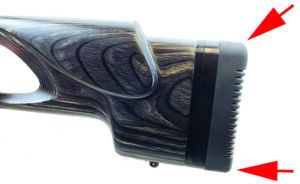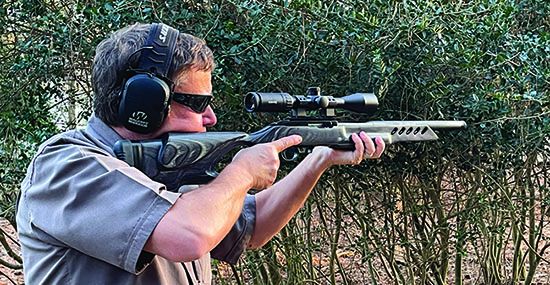Semi-automatic 22 LR rifles are a mainstay with shooters and hunters. These rimfire rifles are fun to shoot and offer fast follow-up shots when plinking, small-game hunting, informal precision shooting, or pinging steel plates. Plus, ammo is inexpensive. However, not all 22 rimfire rifles can do all things well. That’s why there are specialized models. For this match up, we wanted to look at 22 LR semi-auto rifles that could easily be used for hunting as well as dabble in fast shooting competition, or maybe punch tiny groups at the local range for bragging rights among our pals. We didn’t want to feel undergunned or overgunned in the scenarios mentioned above, but we wanted a moderately priced do-all type of rifle/scope combo. Must-haves for these rifle/scope combos were: accuracy, a trigger that would not force us to cuss, comfortable stock, and mounting an optic needed to be easy and simple. If the rifle were further customizable, it earned bonus points. The three rifles in this review are the Bergara BXR, Ruger 10/22 Target, and Savage A22.
How We Tested
We mounted scopes on the rifles and zeroed in at 50 yards. The Savage came with a two-piece Weaver base mounted on the receiver, and it was simple and easy to mount the optic. Mounting a scope on the Bergara was even easier because it came with a Picatinny rail screwed on to the receiver. The Ruger came with a base. Removing the base plug screws were a pain because the finish was heavy and clogged up the tiny screwhead slots. After that, mounting the rail and the scope was a simple task.
A few issues back we tested a Vortex Crossfire II 2-7x32mm rimfire SFP scope ($149; OpticsPlanet.com) with a simple V-Plex MOA reticle similar to a Duplex reticle. We become partial to this scope. We used Vortex Pro Series 1-inch medium-height rings ($79; MidwayUSA.com) to mount the scope to the Savage and the Bergara. On the Ruger, we placed a Hawke Vantage IR 3-9x40mm scope ($159; OpticsPlanet.com) with a Rimfire 22 HV reticle. Because the Ruger came with a Weaver-style scope base adapter that also allows use of claw-style rings, we used NCStar 3⁄8-inch dovetail 1-inch rings ($13; Amazon.com) to attach the scope to the base.

The Ruger is a straight-comb-stock rifle, like an AR-15, and the Hawke Vantage setup offered the correct height for proper eye alignment and shooting comfort. The reticle is a BDC (Bullet Drop Compensating) style reticle calibrated for 22 LR ammunition loaded with 36- to 40-grain bullets with a muzzle velocity range of 1235 to 1260 fps. You need to dial the optic to 9x to use the BDC feature, and it worked well out to 100 yards. There are no hash marks on the horizontal strata to compensate for wind, though there is 2.1-minutes-of-angle (MOA) space between the vertical strata to the thicker duplex horizontal strata, so this can be used to determine a hold. The BDC hash marks are labeled out to 200 yards in 25-yard increments. The reticle also illuminates red or green with five levels of brightness intensity.
Clarity was good for both scopes at this price point. Both scopes have screw-on turret caps, and we would be sure they are screwed on if we were in the field and it started to rain. In our opinion, the BDC reticle in the Hawke is more practical than the V-Plex reticle in the Vortex if you plan on long-range shooting. From plinking distance out to 100 yards, these scopes work well and won’t break the bank.
We purposefully didn’t bore-sight the rifles because ammo was cheap and we wanted to test the turrets and adjustment accuracy on the scopes. Zeroing all the rifles was an easy task. The clicks were solid and easily rotated with our fingers. The direction was clearly marked on both scopes. With the rifles zeroed, we used a bench and rest to gather accuracy data. We also fired the rifles offhand to get a feel for how they would be in the field. Ammunition was inexpensive CCI Blazer with a 38-grain LRN bullet, Federal Auto Match with a 40-grain solid lead bullet, and hot CCI Stangers using 32-grain copper-plated hollow points. Here’s how everything performed at the range:
Ruger 10/22 Target Model 21186 22 LR
$660
Gun Tests grade: A-
The Target is a fast-handling rifle designed for steel-plate competition. For those wanting to get into steel-plate competition, it is a good rifle at a reasonable cost compared to other 10/22 target rifles.

| Action Type | Semi-automatic |
| Overall Length | 35.2 in. |
| Barrel Length | 16.1 in. |
| Twist Rate | 1:16 in. |
| Muzzle Device | None, threaded |
| Sights | Weaver-style scope base adapter |
| Weight Unloaded | 5.0 lbs. |
| Weight Loaded | 5.1 lbs. |
| Capacity | 10 |
| Stock | Laminated thumbhole |
| Stock Length of Pull Adjustable, | 13-14.5 in. |
| Buttplate | Rubber |
| Action Finish | Matte black |
| Barrel Finish | Matte black |
| Magazine Type | Detachable, plastic, 10-rnd. rotary box |
| Trigger Pull Weight | 3.2 lbs. |
| Safety | Manual |
| Accuracy Guarantee | None stated |
| Warranty | None written |
| Telephone | (336) 949 5200 |
| Website | Ruger.com |
| Made In | U.S. |
The 10/22 action is time-proven, iconic, and a benchmark for 22 LR semi-auto rifle design. There are a number of other manufacturers that produce 10/22 knock-off rifles, like Bergara mentioned above, but also Volquartsen, Tactical Solutions, Magnum Research, and others. The 10/22 Target is designed for fast shooting-match competitions, like the Volquartsen and Magnum Research guns, but at a much lower cost.
The Target is built upon the 10/22 receiver and features a unique barrel. The first 4 inches of the barrel out of the receiver is a full 0.9 inches in diameter, typical bull-barrel style that offers great rigidity for better accuracy. The problem with bull-barrel rifles is that they are heavy, so Ruger turned down the rest of the barrel until it is pencil thin and dropped an aluminum sleeve over it that keeps the 0.9-inch barrel diameter. At the muzzle, a special nut is tightened against the sleeve to create tension. This setup provides the rigidity of a full steel barrel without the weight. The rifle weighs 5 pounds without an optic. The muzzle is threaded for a comp, brake, or can.

The left side of the receiver, we noted, was sloppily engraved with the model number and other company info, making the rifle look cheap. The ambidextrous thumbhole stock is gray/black laminated wood that is very comfortable to shoot. The fore end is ventilated with five oblong slots on both sides, creating a gripping surface as well as allowing the barrel to cool quickly. The bottom edge of the fore end is flat for added stability when using a sandbag rest. Sling swivel studs are included, and the front one can double as a bipod attachment. The pistol grip is smooth and contoured so it fits your hand nicely, with a slight palm swell. The comb is smooth and comfortable. The toe is flat for using a toe bag for more stability. The buttpad is rubber with larger radiused ends that allow smooth shouldering. It is also serrated so it sticks to your shoulder. The LOP can be adjusted in half-inch increments with three spacers. We tested with one spacer with an LOP of 14.5 inches. You need to completely remove the recoil pad screw to adjust LOP.
A Ruger BX trigger is standard equipment. It is not adjustable. It is serrated so your finger stays in place when shooting fast. The pull weight measured 3.2 pounds. Nice. There is about a quarter-inch of take up before the trigger breaks. It resets in about a quarter inch of movement. We liked this trigger, and that shows in the range data.
The smallest five-shot group measured 0.49 inches with Federal Auto Match ammo loaded with a 40-grain bullet. A close second was the economy CCI Blazer load, which measured 0.55 inches with a 38-grain bullet. The Federal and CCI Blazer ammo averaged 0.60 and 0.70 inches, respectively. The CCI Stangers averaged 0.84 inches. Accuracy across all the ammo tested measured 0.71 inches for five shots. The Ruger Target was the second most accurate rifle in the match up.
The Hawke scope was a good partner with the Target and helped to enhance the rifle’s long-range performance. With the reticle illuminated, the rifle was fast on closer targets.

Shooting offhand, the Target is very comfortable. The pistol grip has a slight rearward sweep that is comfortable when seated at a bench, prone shooting off a bipod, or shooting offhand. Though the stock is smooth, the shape of the stock provides comfortable grip areas.
The bolt does not remain open after the last shot, similar to all 10/22 guns. And like all 10/22 guns, it needs to be disassembled for a thorough cleaning. Tedious, yes, but simple to disassemble with a hex wrench and punch.
The Target uses the Ruger classic rotary magazine that was easy to load, even to the last round. The magazine release is similar to most Ruger 10/22 rifles — not too small or too big. Pressing the mag release forward with the thumb of your support hand guaranteed the mag would drop into the palm of the support hand. We liked the free-falling magazine. The magazine was easy to insert, and it clicked positively in place.
The manual crossbolt safety is incorporated into the front of the trigger guard like all 10/22 models. The charging handle is 10/22 all the way with a flat blade. It is easy to operate and manipulate, but rounded charging handles are more comfortable to run. The Target balances just forward of the shooting hand so the barrel feels lively and moves quick.
Our Team Said: The Target is lightweight, so we weren’t fatigued shooting it offhand. This is a comfortable rifle to shoot, and it definitely is accurate. Choose this rifle if you want a dedicated steel-plate rifle, we’d trade the scope for a red-dot sight. With the scope, shooting plates fast is possible, but a red dot would provide more field of view. The trigger is clean and crisp. We also like that there are plenty of aftermarket accessories for the 10/22.
| 22 LR RANGE DATA | |||
| CCI Blazer 38-grain LRN | Bergara BXR Steel | Ruger 10/22 Target | Savage A22 BNS-SR |
| Average Velocity | 1239 fps | 1240 fps | 1135 fps |
| Muzzle Energy | 129 ft.-lbs. | 130 ft.-lbs. | 109 ft.-lbs. |
| Smallest Group | 0.45 in. | 0.55 in. | 0.76 in. |
| Average Group | 0.48 in. | 0.70 in. | 0.81 in. |
| Federal Auto Match 40-grain Solid | Bergara BXR Steel | Ruger 10/22 Target | Savage A22 BNS-SR |
| Average Velocity | 1142 fps | 1143 fps | 1139 fps |
| Muzzle Energy | 116 ft.-lbs. | 116 ft.-lbs. | 115 ft.-lbs. |
| Smallest Group | 0.59 in. | 0.49 in. | 0.49 in. |
| Average Group | 0.63 in. | 0.60 in. | 0.57 in. |
| CCI Stangers 32-grain Copper Plated HP | Bergara BXR Steel | Ruger 10/22 Target | Savage A22 BNS-SR |
| Average Velocity | 1515 fps | 1523 fps | 1540 fps |
| Muzzle Energy | 163 ft.-lbs. | 165 ft.-lbs. | 169 ft.-lbs. |
| Smallest Group | 0.89 in. | 0.78 in. | 0.72 in. |
| Average Group | 0.98 in. | 0.84 in. | 0.95 in. |
How we tested: To collect accuracy data, we fired five-shot groups at 50 yards from a bench using a rest. We used a Garmin Zero C1 Pro chronograph to record velocities.
Written and photographed by Robert Sadowski, using evaluations from Gun Tests Team members. GT

























